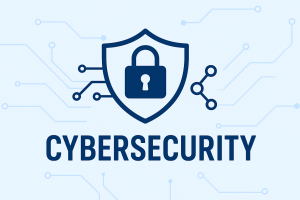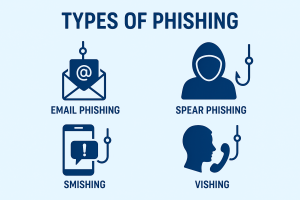
Types of Cyber Crime: Hacking, Phishing, Malware
Cybercrime has now grown into one of the largest threats of the digital era, affecting individuals, businesses, and governments all over the world. Malicious actors now use sophisticated techniques to exploit vulnerabilities across all devices and networks, from data theft to financial fraud. With increased advancement in technology, risks have escalated, raising the stakes for greater awareness and prevention than ever. With the surge in online transactions and remote work environments, there are types of cyber crimes that have become most prevalent. Understand how an attacker operates to keep users more alert and proactive. Also, know about different types of phishing attacks, which remain one of the most successful methods used by cybercriminals to deceive unsuspecting victims, among other information. Also, advanced hacking tools have come into the picture, powering many breaches that enable unauthorized access and exploitation on a large scale. In this blog, we have briefed the most usual cyber threats, how they work, and the steps you can take to stay protected.
Table Of Content
What is CyberCrime
Types of Cyber Crime
Hacking
Understanding Phishing: Mechanics and Risks
Types of Phishing Attacks
Methods of Malware Infection
How Does Malware Function?
Conclusion
Frequently Asked Questions
What is CyberCrime
Hackers and other cybercriminals often target financial gain when committing their crimes. Organisations and individuals are both capable of engaging in these illegal practices. In their pursuit of financial gain, cybercriminals often utilise computers or networks to distribute viruses, malware, explicit content, and other illegal data.
Investigators employ different methods to examine devices suspected of being involved in or targeted by cybercrimes.
Types of Cyber Crime

Hacking
Hacking Tools: Methods Employed by Hackers
Hacking involves technical methods like creating malware, as well as psychological tactics to deceive users into providing personal information. This is known as “social engineering.” Hacking is a broad term that encompasses various malicious activities:
- Denial of service attacks
- Botnets
- Browser hijacks
- Ransomware Rootkits
- Viruses
- Trojans
- Worms
Denial of Service (DoS)
Denial of Service (DoS) Attacks are one of the most commonly employed malicious activities. It aims to disrupt network service by overwhelming it with excessive data traffic. A distributed denial-of-service (DDoS) attack is the most common type of attack, in which several machines are set up to attack the targeted system with traffic. People may frequently be ignorant of the infection on their machines and unintentionally support the DoS attack.
Botnets
A botnet is a bunch of computers that are being affected infected by a bad software. It’s like an army of robots controlled by one person called the “bot-herder.” Each computer in the botnet is called a bot. The bot-herder can give orders to all the computers at once and make them do criminal actions together. Because there can be millions of bots in a botnet, the attackers can carry out these criminal activities on a large scale.
Browser hijacks
A browser hijacker is a hacking program that changes how your web browser works without asking you. It makes your browser go to websites you didn’t want to visit. People also call it a browser redirect virus because it sends your browser to other websites, which can be harmful.
Ransomware Rootkits
A rootkit is a malware program that sneaks into a computer and tries to hide itself and other threatening programs. It can get into a computer in two ways. Sometimes, an attacker installs it directly on the computer. Other times, they use a weak spot in the computer’s defences to install it from far away. Once the rootkit is inside, it hides itself and indulge in a malicious activity.
Viruses
A computer virus is threatening software that can move from one computer to another and harm data and other software just like microbial viruses do. Its goal is to make create major problems for the computers and disrupt its functioning. It also has the potential to delete data or share them without permission.
Trojans
Trojans are sneaky programs that pretend to do something fruitful but actually does the opposite. They can look like free software, videos, music, or even normal ads. Trojans can be used by attackers on their own to do malicious activities.
Worms
A self-replicating virus known as a worm, uses security flaws to spread throughout a network and exploit information theft, backdoor installation, and other sorts of damage. Unlike viruses, worms can function independently without a host computer. They consume significant memory and bandwidth, leading to system and network overload.
Phishing
Phishing is a sort of online crime in which a targeted person is approached through email, phone call, or text message by a fraudster. They pretend to be a representative of a reliable organisation to trick people into disclosing sensitive information, including passwords, banking and credit card information, and personal identifiable information (PII).
After that, the data is used to log into crucial accounts, which may lead to identity theft and financial loss.
Understanding Phishing: Mechanics and Risks
Firstly, attackers can exploit the obtained information for financial gain, such as credit card fraud. Moreover, phishing attacks can serve as a gateway for more sophisticated cybercrimes like advanced persistent threats (APTs) and ransomware, targeting individuals or organisations by obtaining login credentials or other valuable data.
Understanding the mechanics and risks of phishing is crucial in protecting against these malicious activities.
Types of Phishing Attacks

Deceptive Phishing
Attackers trick victims into revealing confidential information through fake emails by posing as a bank and asking for account details.
Spear Phishing
Specific individuals are targeted, with attackers customising their communication based on researched information to appear authentic.
Whaling
Attackers target high-level executives to steal their login credentials and access valuable company information.
Pharming
Victims are directed to fraudulent websites that appear legitimate, either through infected computers or manipulated DNS servers.
Malware
The abbreviation “malware,” which stands for “malicious software,” refers to any programme or piece of code developed with the intention of damaging or abusing computer systems, networks, or other technology. Malware comes in the form of viruses, worms, Trojan horses, ransomware, and spyware.
Its goal is to cause harm or disruption, steal confidential information, get unauthorised access, or seize control of a system.
Methods of Malware Infection
How Does Malware Function?
Malware is created to infect networks and devices with the intention of causing harm to the affected systems and their users. The impact of malware varies depending on its type and objectives. While some malware may have mild or harmless effects, others can lead to severe consequences.
No matter what technique is used, all malware targets devices and, at the expense of the user, benefits the hackers who used it.
Thus, in order to protect yourself from the ever-evolving threats in the digital domain, it is crucial to grasp the knowledge of various types of cybercrime, such as hacking, phishing and malware, as it has now become essential for people and organisations to equip themselves with the skills and information necessary to ward off such attacks.
Conclusion
Understanding the different types of cyber crimes is important in a world where digital threats are rapidly evolving. As attacks become increasingly sophisticated, the ability to recognize the common types of phishing attacks becomes key for individuals and organizations in terms of protecting sensitive data. The cybercriminals now have advanced hacking tools that guarantee systems compromise within mere seconds, making the ability to be aware and prevent such hacks all the more crucial. We can build a much safer digital environment if we continue updating our knowledge on the latest types of cyber crimes, ensure safe online behavior, and upgrade security.
Frequently Asked Questions
The Type 2 cyber crime mostly denotes criminal acts involving unauthorized access to and exploitation of systems, mostly for financial gains or data theft. These also come under the general categories of types of cyber crimes. Knowledge of types of phishing attacks and how the attackers use the hacking tools enables an organization to detect such intrusions and respond swiftly.

